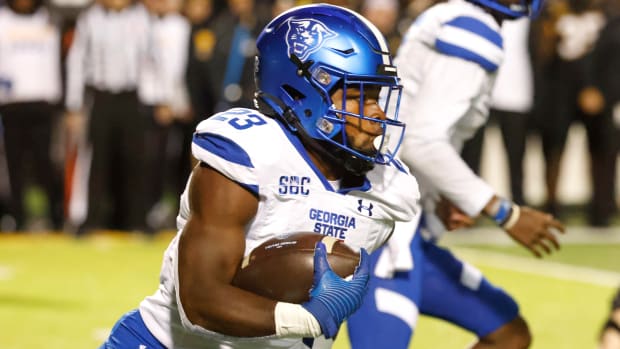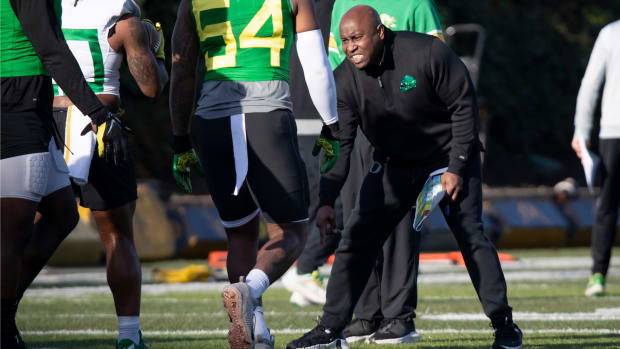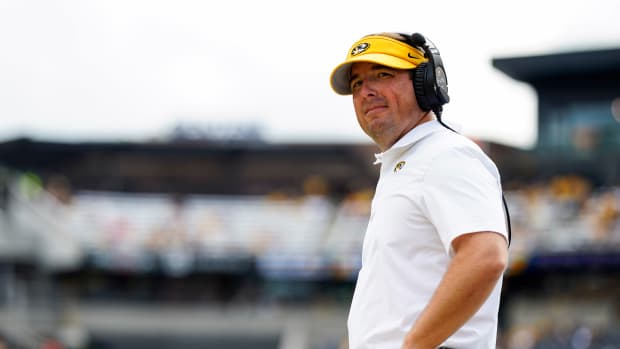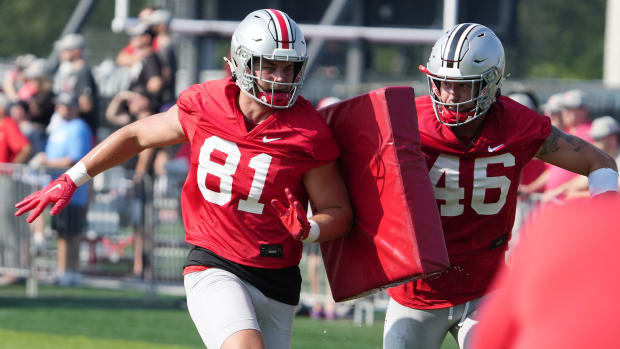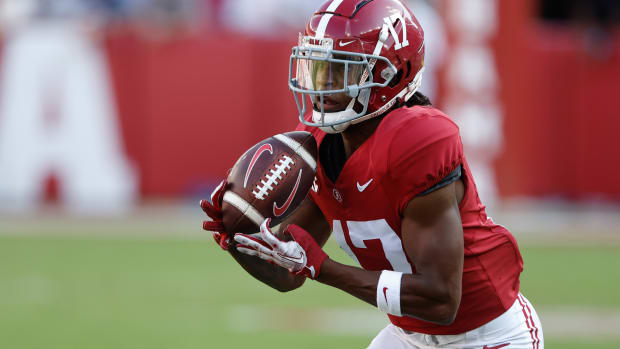Grading All 27 Head Coaching Hires of College Football's 2018–19 Coaching Carousel
College football’s hiring season has been marked by surprises (Urban Meyer’s retirement), the return of one of the game’s most popular personas (Les Miles at Kansas) and 30-somethings and 60-somethings alike getting the nod for enticing gigs. All 27 jobs that came open have been filled, and we grade them all below on five criteria that earn scores between 1 (the worst) and 5 (the best) that are averaged:
• Splash quotient: Looking at the reaction to the hire from media, fans, players, anyone. Did people like it, hate it, even realize it happened?
• Geography: We’re talking recruiting, connections (be it to the school, the region, the conference), anything that might make a coach fit in culturally.
• Stylistic fit: How smooth will the transition be to this coach’s system? How much does his system make sense given his new school’s recent identity?
• Execution: This takes into account the ease and professionalism with which each program made its hire. Was there drama? Miscommunications? Civic unrest?
• Instant impact: How safely can this team expect to be significantly better than it was this year—or, for the best teams on the list, at the same elite level—in the near future?
Keep in mind that these hires are graded on somewhat of a curve; just because a smaller school has no chance of landing the biggest fish on the market doesn’t mean it can’t land above a Power 5 program in these rankings for making the best hire possible given its means. With that, let’s get into the grades, starting with this year’s best hire.
Houston: Dana Holgorsen (4.4 out of 5)
Splash quotient: 5
Geography: 5
Stylistic fit: 4
Execution: 4
Instant impact: 4
Luring a non-fired Power 5 coach to a Group of Five program is no small feat, and when it’s Holgorsen, who has history winning at Houston and in the state of Texas, that’s huge. Sure, the Cougars’ decision to fire Major Applewhite after two full seasons and a 15–10 record (he did lose all three bowl games he coached, the last in spectacular fashion) wasn’t the greatest look, but Houston saw an opportunity to get Holgorsen and his high-flying offense, and it moved swiftly; now, the Cougars look like they could be back atop the Group of Five and clamoring for a New Year’s Six bid. Their strong nonconference schedule—Oklahoma State and Washington State in 2019, and a total of seven Power 5 opponents over the next four years—doesn’t hurt that prospect.
Miami: Manny Diaz (4.4)
Splash quotient: 5
Geography: 5
Stylistic fit: 5
Execution: 3
Instant impact: 4
It’s tempting to knock Miami for turning around and poaching another team’s newly hired coach, a coach who left the Hurricanes’ staff last month—but at the same time, it’s also impossible not to commend the program for getting exactly the guy they wanted, and the best guy for the job. Mark Richt’s retirement clearly came as a bit of a surprise, but Miami needs a jolt, and Diaz, the architect of their strong defenses these past three seasons, should provide it. The Hurricanes have plenty of talent, but they came up far short in 2018 after fading fast in Richt’s first year. Leaning into a defensive identity under Diaz is the right move, but the Hurricanes will need to find an answer for their offensive struggles, and quickly, under new offensive coordinator Dan Enos.
West Virginia: Neal Brown (4.2)
Splash quotient: 4
Geography: 4
Stylistic fit: 5
Execution: 5
Instant impact: 3
West Virginia may have missed its best shot to make playoff waves in 2018, as a lot of big-time is leaving Morgantown this offseason. That’ll be a tough hurdle for Brown, but he’s a fantastic hire: like Holgorsen, he’s a disciple of the Air Raid offense, and at Troy, he won 10 games in each of the last three seasons after inheriting a team that went 3–9 in the year prior to his arrival. The Mountaineers aren’t going to be the turnaround Troy was, but Brown’s skills will be valuable in a tough recruiting state, where he’ll need to get the most out of talent resources that may on paper be less plentiful than it is for his chief opponents in the Big 12.
Georgia Tech: Geoff Collins (4.2)
Splash quotient: 3
Geography: 5
Stylistic fit: 5
Execution: 4
Instant impact: 4
Paul Johnson’s flexbone is likely history on The Flats—but Georgia Tech under Collins will likely run a spread offense with elements of the triple option sprinkled in, still getting the most out of the Yellow Jackets’ skill players while also going a bit more mainstream (which should help open up the recruiting pool). But Collins—who spent four years at Tech from 1999–2001 and again in 2006 and is familiar with the team and its landscape—is a defensive coach, and his new team desperately needs a makeover on that side of the ball.
Troy: Chip Lindsey (4.0)
Splash quotient: 4
Geography: 5
Stylistic fit: 4
Execution: 4
Instant impact: 3
Lindsey inherits a program that has put up double-digit wins in each of the last three seasons under Neal Brown—so his task will be maintaining the status quo. He comes to Troy after barely more than a month as Kansas’s offensive coordinator, a kind of homecoming for the Alabama native who spent the past two seasons as Auburn’s OC and was Troy’s quarterbacks coach in 2010. As a longtime Alabama high school coach, Lindsey knows the territory intimately and seems thrilled to inherit a program that isn’t a total rebuild, so Troy appears in good hands.
Ohio State: Ryan Day (4.0)
Splash quotient: 3
Geography: 4
Stylistic fit: 5
Execution: 5
Instant impact: 3
The splash came when Urban Meyer announced his retirement—Day’s promotion from offensive coordinator was an afterthought by comparison. Ohio State may be going from one of the winningest coaches in college football history to a 39-year-old with a 3–0 record as an interim, but it’s still loaded with talent and has proven it can contend for championships no matter who’s in charge. Day passed the interim test with flying colors during Meyer’s September suspension, and he’s been the man behind the Buckeyes’ excellent offense for the past two seasons. It may be time for some fresh perspective in Columbus, and Day will bring that—without too much of a seismic shift from the system that has won back-to-back Big Ten titles.
NIESEN: Five Lingering Questions About Where Ohio State and Urban Meyer Go From Here
Appalachian State: Eliah Drinkwitz (4.0)
Splash quotient: 3
Geography: 5
Stylistic fit: 5
Execution: 4
Instant impact: 3
Drinkwitz is inheriting a heck of a program for his first head-coaching job, and it’s not as if one of the Group of Five’s best teams this year has a whole lot to improve upon. That said, Drinkwitz, who was most recently NC State’s offensive coordinator, has a track record that suggests he might give the Mountaineers’ offense a bit of a jolt. In his three years in Raleigh, the Wolfpack improved from a so-so unit to a top-25 one. He has a history of developing quarterbacks, and he knows the region, so as long as he surrounds himself with some experience on his staff, which seems likely, the momentum created by Scott Satterfield should continue.
Texas Tech: Matt Wells (4.0)
Splash quotient: 4
Geography: 3
Stylistic fit: 5
Execution: 5
Instant impact: 3
In 2018, the Red Raiders averaged 484.3 yards per game; Wells’s last Utah State team averaged 493.8. He’s a perfect fit for Texas Tech, which will retain its offensive identity under new coordinator David Yost but also needs a major overhaul on defense that it may not get under Keith Patterson, who captained a good unit at Utah State this year but faces a much taller task slowing down Big 12 offenses. Sitll, mere competence on that side of the ball would represent an upgrade.
Kansas State: Chris Klieman (4.0)
Splash quotient: 5
Geography: 4
Stylistic fit: 4
Execution: 3
Instant impact: 4
Kansas State took its time to make the hire that would replace legendary coach Bill Snyder, but when it made its decision, it was a great one. Though Klieman has never been a head coach at the FBS level (his only year as an FBS assistant came in 1997 at Kansas), he has lost exactly six games in five years at the helm of FCS powerhouse North Dakota State, a record that should be enough to quiet the K-State fans who griped at the hire. The coach has a great relationship with athletic director Gene Taylor, who was the Bisons AD from 2001 to ’14, and although transitioning from a lower level will be a test, Klieman looks up to the task, especially if he can hire an ace offensive coordinator. Although the Wildcats had a down year in ’18, going 5–7 and missing a bowl for the first time since the first season of Snyder’s second stint back in 2009, there’s plenty to work with in Manhattan going forward.
Western Kentucky: Tyson Helton (4.0)
Splash quotient: 3
Geography: 4
Stylistic fit: 4
Execution: 5
Instant impact: 4
Under Jeff Brohm, Western Kentucky went 8–5, then 12–2, then 11–3. In the two years under Mike Sanford after Purdue hired Brohm away, the Hilltoppers won six and then three games. Helton is a callback to better times; he was the offensive coordinator and quarterbacks coach for Brohm’s first two years in Bowling Green, so he knows the program and the style of play that led to its success. From there, Helton spent two years coaching Sam Darnold at USC and last year as Tennessee’s OC. It hasn’t been long since the Hilltoppers were relevant, so Helton could get them back there somewhat quickly.
NorthernIllinois: Thomas Hammock (4.0)
Splash quotient: 4
Geography: 5
Stylistic fit: 4
Execution: 4
Instant impact: 3
The NorthernIllinois coaching search smartly focused on candidates with ties to the university, and in Hammock, they get both an NIU legend and a guy with coaching experience at the college and professional level. Hammock has been the Ravens’ running backs coach since 2014, which doesn’t necessarily translate to preparedness for an FBS head coaching job. That said, Hammock’s presence will be great for recruiting, and he has a ton of experience in the upper Midwest; the former running back coached his position at Minnesota and Wisconsin, and he was also the Gophers’ offensive coordinator for the 2010 season.
Temple: Rod Carey (3.8)
Splash quotient: 3
Geography: 3
Stylistic fit: 4
Execution: 5
Instant impact: 4
Poor Temple. It’s been a rough month for the Owls, who thought they’d nabbed an A+ hire for their vacant head coaching position and then watched Manny Diaz bolt for Miami after Mark Richt retired. Temple took a minute to regroup before moving on, and it sound like it did so scrupulously, casting a wider net and looking for a coach who might stay longer than a year, much less a month. They handled a tough situation admirably, and in the coach of the MAC champions, they came up with a good hire, if not a splashy one. Since replacing Dave Doeren at Northern Illinois at the end of 2012, Carey has taken the Huskies to bowl games in all but one season—but not yet won one. He’ll need to get over that hump at Temple.
Coastal Carolina: Jamey Chadwell (3.8)
Splash quotient: 2
Geography: 5
Stylistic fit: 5
Execution: 5
Instant impact: 2
Chadwell returned to his originally intended job description as Coastal Carolina’s offensive coordinator last year after filling in as the Chanticleers’ head coach in 2017 when Joe Moglia took a five-month medical sabbatical. So he’s done this before, sort of. Prior to his arrival in Myrtle Beach, Chadwell was a head coach at the Division II and FCS level (North Greenville, Delta State and Charleston Southern), and with Moglia stepping down but continuing as the school’s chairman of athletics, Chadwell will have some experience to guide him in his first FBS head coaching job. He inherits the program at a tough juncture, though: The Chanticleers haven’t had a winning season in the FBS yet, and any kind of instant improvement is going to be tough.
Louisville: Scott Satterfield (3.8)
Splash quotient: 3
Geography: 4
Stylistic fit: 4
Execution: 4
Instant impact: 4
Satterfield may have been Louisville’s second choice after Jeff Brohm turned his alma mater down, but that doesn’t mean Cardinals AD Vince Tyra didn’t make a great hire. Having led Appalachian State through its FCS-to-FBS transition, Satterfield is proficient in doing a lot with very little (and Louisville’s current roster situation is the epitome of very little), and he’s also proven to be an exceptional talent evaluator, never making much of a recruiting splash but continually fielding one of the Group of Five’s best teams. It’s going to take a minute for Louisville to regain its foothold in an ACC where Clemson has a chokehold on the top spot and other traditionally strong teams look better poised to rebound. Still, the Cardinals are headed in the right direction.
North Carolina: Mack Brown (3.6)
Splash quotient: 4
Geography: 4
Stylistic fit: 3
Execution: 5
Instant impact: 2
Brown’s name means something in North Carolina, where he coached from 1988 to ’97 and took the Tar Heels from one-win seasons in his first two years to 10 wins in his final two. He has always been an ace recruiter, and even now, in his late 60s, that should still hold true. That said, he’s been out of the coaching game for five years, and his time at Texas didn’t exactly end on great terms. North Carolina has had plenty of talent on its roster in recent years, but Larry Fedora wasn’t able to make the most of it toward the end, and that’ll be Brown’s test, too.
Central Michigan: Jim McElwain (3.6)
Splash quotient: 2
Geography: 5
Stylistic fit: 4
Execution: 4
Instant impact: 3
Geographically, this makes sense: McElwain has spent the past season getting familiar with the state of Michigan as the Wolverines’ wide receivers coach. Still, the former Florida head man has a tough job ahead of him; the Chippewas won one game—against an FCS team—in 2018. This may be a slower rebuild, but McElwain has taken a Group of Five team out of purgatory before during his three-year run at Colorado State.
Kansas: Les Miles (3.6)
Splash quotient: 5
Geography: 2
Stylistic fit: 3
Execution: 5
Instant impact: 3
Hiring Miles was about the splashiest thing Kansas could have done, considering the coaches available this year—even if it may not be the most prudent move long-term. Turning around the Big 12’s worst program after so many years in the SEC is going to be an adjustment, and recruiting will be an entirely different challenge than it was at LSU with the stink that has attached itself to Jayhawk football. Miles, whose rosters in Baton Rouge were stocked with NFL talent that didn’t always line up with the on-field results, will now have to seek out under-recruited players and maximize their production. David Beaty left the program in a much better spot than it was when he took over, which may ease the Mad Hatter’s transition.
Texas State: Jake Spavital (3.6)
Splash quotient: 3
Geography: 4
Stylistic fit: 4
Execution: 4
Instant impact: 3
Spavital is one of the best young offensive minds in the game, and he’s worked with one of the country’s best offenses the past two seasons at West Virginia. He also has Texas ties after working on Kevin Sumlin’s Texas A&M staff as offensive coordinator and quarterbacks coach. Texas State only joined the FBS in ’12 and hasn’t had a winning season since ’14, so the improvement from this fall’s three-win campaign will be gradual. Still, the Bobcats need an offensive overhaul after mustering just 19.8 points per game last year, and Spavital should be able to get that turnaround started quickly.
Utah State: Gary Andersen (3.4)
Splash quotient: 4
Geography: 5
Stylistic fit: 3
Execution: 3
Instant impact: 2
Andersen was a comfortable choice for Utah State; he coached the Aggies from 2009–12, and his success there was a springboard to his first Power 5 head-coaching job at Wisconsin. He’s spent 18 years of his career in the state of Utah, so he’ll be walking back into familiar territory, but Andersen isn’t exactly coming off a great showing as a head coach. In 2018, he was Utah’s associate head coach and defensive assistant, but prior to that, he went a combined 7–23 at Oregon State from 2015–17. Maybe the Utah State gig, in a spot where Andersen is comfortable and with a strong roster that went 10–2 in 2018, is an easier landing spot; there’s no rebuild here, and all Anderson needs to do is stay the course for one of the Group of Five’s most talented teams this season.
Maryland: Mike Locksley (3.4)
Splash quotient: 2
Geography: 5
Stylistic fit: 4
Execution: 2
Instant impact: 4
Maryland has a lot going for it with this hire. Locksley spent two stints a decade apart in College Park as an assistant prior to DJ Durkin’s tenure, he’s one of the most respected recruiters of the D.C.-Maryland-Virginia area and he has a ton of support from Maryland boosters and local fans. On top of that, he will arrive on campus in a full-time capacity only after leading the best offense Alabama has fielded under Nick Saban into the College Football Playoff. Maryland has some talent in place, but after a season of tragedy and administrative instability, it’s ready for a fresh start. In his first and only head coaching job at New Mexico from 2009 to ’11, Locksley was accused of age and sex discrimination (all legal claims were resolved) and served a one-game suspension for punching an assistant. This is not to say he doesn’t deserve a second chance after a nearly a decade, but Maryland would have been forgiven for hiring someone with as clean of a record as possible after the year it has endured.
STAPLES: Who Will Be Alabama's Next Offensive Coordinator?
East Carolina: Mike Houston (3.4)
Splash quotient: 3
Geography: 5
Stylistic fit: 4
Execution: 2
Instant impact: 3
Houston was hired at East Carolina after a bizarre few days for both him and his new school; the former James Madison coach was lined up to take the Charlotte job before his eye was drawn to ECU, which fired Scottie Montgomery two days before its regular-season finale against NC State. The Pirates are still reeling from the bizarre termination of Ruffin McNeill after the 2015 season, and Montgomery never got things rolling after being hired away from David Cutcliffe’s Duke staff. Houston has been wildly successful at college football’s lower levels, with an 80–25 record as a head coach and a 2016 FCS title at James Madison, and he also has deep ties to the state of North Carolina and the Mid-Atlantic region.
Colorado: Mel Tucker (3.4)
Splash quotient: 3
Geography: 2
Stylistic fit: 4
Execution: 4
Instant impact: 4
Colorado took a few days to make it official with Tucker, but the delay was worth it for a low-hype but potentially high-return hire. Coaching and recruiting in the Pac-12 will be an adjustment for a coach who has spent most of his career in the SEC or the NFL, but snagging a branch off the Nick Saban coaching tree is no small victory for Colorado, which lost its final seven games of 2018. Tucker’s defense this year at Georgia was No. 13 in the FBS in yards allowed, and he’ll be an instant upgrade on that side of the ball. It’ll be fascinating to see who he can snag to run the Buffs’ offense, which struggled once injuries slowed down do-everything wideout Laviska Shenault.
Charlotte: Will Healy (3.2)
Splash quotient: 2
Geography: 4
Stylistic fit: 3
Execution: 3
Instant impact: 4
If this hire had been made a year ago, after Healy had taken Austin Peay to an 8–4 record after the Governors won just one game between 2014 and ’16, it might have been met with more fanfare. Healy’s Governors were 5–6 this year, but five wins at Austin Peay is still remarkable. The 33-year-old Healy got the job after East Carolina drew Mike Houston’s eye, and he is a more than acceptable second choice for a program still establishing its identity; its five-win season this year was its best in four seasons of FBS ball.
UMass: Walt Bell (3.0)
Splash quotient: 2
Geography: 2
Stylistic fit: 3
Execution: 5
Instant impact: 3
Bell, 34, marks a bit of a 180 for UMass, which had spent the past five seasons under the direction of 61-year-old Mark Whipple. Bell doesn’t exactly come to the Minutemen riding recent success after coordinating Florida State’s disastrous offense in 2018, but before that, his units at Maryland and Arkansas State had been high-scoring ones. Bell is a strong recruiter, and that will be a key facet of his value to an independent that has not won more than four games since rejoining the FBS in 2012.
Bowling Green: Scot Loeffler (3.0)
Splash quotient: 3
Geography: 3
Stylistic fit: 3
Execution: 3
Instant impact: 3
Loeffler, a first-time head coach who was Boston College’s offensive coordinator from 2016 to ’18, has hammered home his desire to hire an exceptional staff, and so far, he’s retained defensive coordinator Carl Pelini and brought back Terry Malone, who was an assistant at Bowling Green from 1986 to ’95 and will take over as offensive coordinator. That continuity will be key, because Loeffler’s résumé doesn’t exactly portend a quick turnaround for a program that hasn’t had a winning season since Dino Babers was coach in 2015. Loeffler has worked under some of the biggest names in the business, including Frank Beamer, Urban Meyer and Lloyd Carr, but his uninspiring coordinator stints at Virginia Tech and Auburn did not endear him to fans. Boston College averaged 32 points per game this year, but before AJ Dillon showed up in Chestnut Hill, Eagles fans had grown similarly tired of Loeffler’s punchless offenses.
Akron: Tom Arth (3.0)
Splash quotient: 1
Geography: 5
Stylistic fit: 3
Execution: 3
Instant impact: 3
Arth, who has served as the head coach of the University of Tennessee at Chattanooga for the past two years, has deep Ohio ties. He played at John Carroll, a Division III school about 40 minutes from Akron, and then coached there from 2010–16. At Chattanooga, he didn’t have big-time success; his team went 3–8 last year and 6–5 this fall. The Mocs had a tough second half to the season, going 2–5 in their last seven games. Given the state Terry Bowden left Akron in, it should take a few seasons to right the ship.
Liberty: Hugh Freeze (2.8)
Splash quotient: 3
Geography: 3
Stylistic fit: 2
Execution: 3
Instant impact: 3
Freeze is barely more than a year removed from leaving something close to scorched earth behind him at Ole Miss: rampant NCAA violations, sanctions and a laundry list of uncouth actions in his personal life. But thanks to the cheating he was more than happy to employ, Ole Miss got some good recruits, and it got good, and it beat Alabama—twice. That was enough for Liberty, the Christian university that joined the FBS right around the time Freeze was ousted. It got a big name, but one with a recent track record for ravaging the program he coached in an effort to win. Maybe Liberty thinks he can coach it to something like relevance, but there’s little evidence he’ll do so without at least bending the rules.
